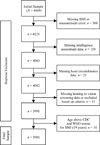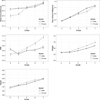Physical growth and nonverbal intelligence: associations in Zambia
- PMID: 25217196
- PMCID: PMC4252808
- DOI: 10.1016/j.jpeds.2014.07.058
Physical growth and nonverbal intelligence: associations in Zambia
Abstract
Objective: To investigate normative developmental body mass index (BMI) trajectories and associations of physical growth indicators--height, weight, head circumference (HC), and BMI--with nonverbal intelligence in an understudied population of children from sub-Saharan Africa.
Study design: A sample of 3981 students (50.8% male), grades 3-7, with a mean age of 12.75 years was recruited from 34 rural Zambian schools. Children with low scores on vision and hearing screenings were excluded. Height, weight, and HC were measured, and nonverbal intelligence was assessed using the Universal Nonverbal Intelligence Test, Symbolic Memory subtest and Kaufman Assessment Battery for Children, Second Edition, Triangles subtest.
Results: Students in higher grades had a higher BMI over and above the effect of age. Girls had a marginally higher BMI, although that for both boys and girls was approximately 1 SD below the international Centers for Disease Control and Prevention and World Health Organization norms. When controlling for the effect of age, nonverbal intelligence showed small but significant positive relationships with HC (r = 0.17) and BMI (r = 0.11). HC and BMI accounted for 1.9% of the variance in nonverbal intelligence, over and above the contribution of grade and sex.
Conclusion: BMI-for-age growth curves of Zambian children follow observed worldwide developmental trajectories. The positive relationships between BMI and intelligence underscore the importance of providing adequate nutritional and physical growth opportunities for children worldwide and in sub-Saharan Africa in particular. Directions for future studies are discussed with regard to maximizing the cognitive potential of all rural African children.
Copyright © 2014 Elsevier Inc. All rights reserved.
Conflict of interest statement
The authors declare no conflicts of interest.
Figures



Similar articles
-
[Nutritional status and height development of rural children aged 10-12 years in Linxia Hui Autonomous Prefecture, Gansu Province, and the relationship with intelligence quotient in 2019].Wei Sheng Yan Jiu. 2024 Nov;53(6):956-998. doi: 10.19813/j.cnki.weishengyanjiu.2024.06.017. Wei Sheng Yan Jiu. 2024. PMID: 39719346 Chinese.
-
Height, weight and BMI percentiles and nutritional status relative to the international growth references among Pakistani school-aged children.BMC Pediatr. 2012 Mar 19;12:31. doi: 10.1186/1471-2431-12-31. BMC Pediatr. 2012. PMID: 22429910 Free PMC article.
-
Blood pressure levels of Zambian rural adolescents and their relationship to age, sex, weight, height and three weight-for-height indices.Int J Epidemiol. 1992 Apr;21(2):246-52. doi: 10.1093/ije/21.2.246. Int J Epidemiol. 1992. PMID: 1428476
-
Association of insulin-like growth factor I and insulin-like growth factor-binding protein-3 with intelligence quotient among 8- to 9-year-old children in the Avon Longitudinal Study of Parents and Children.Pediatrics. 2005 Nov;116(5):e681-6. doi: 10.1542/peds.2004-2390. Pediatrics. 2005. PMID: 16263982
-
School effects on non-verbal intelligence and nutritional status in rural Zambia.Learn Individ Differ. 2016 Feb;46:25-37. doi: 10.1016/j.lindif.2015.04.004. Epub 2015 Apr 25. Learn Individ Differ. 2016. PMID: 27175053 Free PMC article.
Cited by
-
Paired Associate Learning Tasks and their Contribution to Reading Skills.Learn Individ Differ. 2016 Feb;46:54-63. doi: 10.1016/j.lindif.2014.12.003. Learn Individ Differ. 2016. PMID: 27175054 Free PMC article.
-
Getting Something out of Nothing: Analyzing Patterns of Null Responses to Improve Data Collection Methods in sub-Saharan Africa.Learn Individ Differ. 2016 Feb;46:11-16. doi: 10.1016/j.lindif.2014.11.024. Epub 2014 Nov 26. Learn Individ Differ. 2016. PMID: 27175051 Free PMC article.
-
Abnormal body mass index may be related to poor social function of female children by a propensity score matching analysis.Sci Rep. 2021 Mar 18;11(1):6333. doi: 10.1038/s41598-021-85911-1. Sci Rep. 2021. PMID: 33737721 Free PMC article.
-
Relationship between Stunting, Wasting, Underweight and Geophagy and Cognitive Function of Children.J Trop Pediatr. 2020 Oct 1;66(5):517-527. doi: 10.1093/tropej/fmaa009. J Trop Pediatr. 2020. PMID: 32129870 Free PMC article.
-
Identifying learning patterns of children at risk for Specific Reading Disability.Dev Sci. 2016 May;19(3):402-18. doi: 10.1111/desc.12313. Epub 2015 Jun 2. Dev Sci. 2016. PMID: 26037654 Free PMC article.
References
-
- Ivanovic DM, Leiva BP, Perez HT, Olivares MG, Diaz NS, Urrutia MS, et al. Head size and intelligence, learning, nutritional status and brain development. Head, IQ, learning, nutrition and brain. Neuropsychologia. 2004;42(8):1118–1131. - PubMed
-
- Ivanovic R, Forno H, Castro CG, Ivanovic D. Intellectual ability and nutritional status assessed through anthropometric measurements of Chilean school-age children from different socioeconomic status. Ecology of Food and Nutrition. 2000;39:1–25.
-
- Jensen AR, Johnson FW. Race and sex differences in head size and IQ. Intelligence. 1994;18:309–333.
-
- Jensen AR, Sinha SN. Biological factors and psychometric intelligence. In: Vernon PA, editor. Biological approaches to research on human intelligence. Norwood, NJ: Ablex; 1993. pp. 139–242.
Publication types
MeSH terms
Grants and funding
LinkOut - more resources
Full Text Sources
Other Literature Sources
Medical

